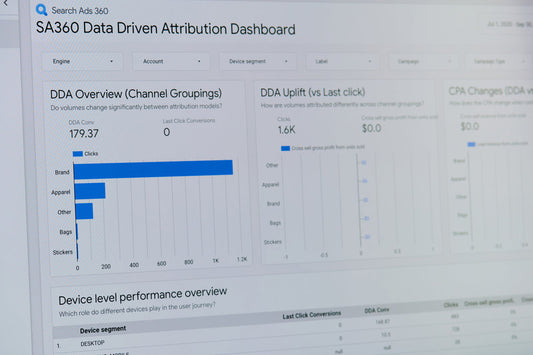In the fast-paced realm of e-commerce, the significance of an inclusive and accessible online shopping experience cannot be overstated. Beyond ethical considerations, it's now a strategic business imperative.
As a Shopify website design and digital marketing agency dedicated to empowering e-commerce brands, we recognize the unique challenges and opportunities inherent in catering to diverse audiences. In this comprehensive guide, we'll delve into the importance of accessibility on the Shopify platform and provide actionable insights to help your e-commerce brand thrive while making a positive impact.
Understanding the Need for Accessibility
1. The Inclusive Shopping Landscape:
The modern market is evolving, and so are the consumers. Differently-abled individuals constitute a substantial portion of potential customers. By tailoring your online store to meet their needs, you not only tap into an expanding market but also contribute to a more inclusive digital landscape. The economic impact of serving diverse audiences extends beyond immediate sales to brand loyalty and positive word-of-mouth.
2. Legal Considerations:
Web accessibility is not just a courtesy; it's a legal requirement. Familiarize yourself with legal frameworks, such as the Americans with Disabilities Act (ADA), emphasizing the importance of making your website accessible to all. Compliance not only mitigates legal risks but also fosters trust and credibility with your audience.
Shopify's Commitment to Accessibility
1. Built-In Features:
One of the advantages of using Shopify is its commitment to accessibility. The platform comes equipped with built-in features that contribute to a more inclusive user experience. From responsive themes to mobile-friendly designs, Shopify lays the groundwork for an accessible storefront right from the start.
2. Third-Party Apps and Integrations:
Beyond native features, Shopify boasts a robust ecosystem of third-party apps and integrations. Explore apps specifically designed to enhance accessibility, such as those offering improved navigation or compatibility with assistive technologies. Integrating these tools can elevate your store's user experience.
Practical Tips for an Accessible Shopify Store
1. Optimizing Product Descriptions:
Craft clear and concise product descriptions that provide essential information. Consider diverse learning styles and incorporate alternative text for images to ensure that your content is accessible to all.
2. Navigational Ease:
Simplify navigation for a seamless user experience. Organize product categories logically and ensure that users can easily move through your site with minimal effort. A straightforward navigation structure benefits everyone, regardless of ability.
3. Responsive Design for All Devices:
Mobile accessibility is a non-negotiable aspect of e-commerce. Ensure that your Shopify store is optimized for various devices, accommodating users who shop on smartphones, tablets, or desktop computers. Responsive design is key to reaching a broader audience.
4. Color and Contrast Guidelines:
Consider the impact of color on readability and ensure sufficient contrast for all users. Opt for accessible color choices that enhance visibility, especially for those with visual impairments.
5. Assistive Technology Compatibility:
Test your website's compatibility with various assistive technologies, such as screen readers or voice command systems. Understanding how your site interacts with these tools is crucial for providing an inclusive experience.
User Experience and Beyond
1. Feedback and Continuous Improvement:
Invite feedback from users with diverse needs. Regularly assess your website's performance with assistive technologies, and be proactive in implementing improvements. Accessibility is an ongoing process, and user feedback is a valuable resource for refinement.
2. Educating Your Team:
Ensure that your team is aware of the importance of accessibility. Provide ongoing training to keep them informed about the latest best practices and technologies. A team-wide commitment to accessibility is integral to the success of your inclusive e-commerce strategy.
Examples (i.e. how the big guys do it)
Take a look at how the 'big guys' approach accessibility online and learn from them!
Conclusion
As you embark on the journey of creating an accessible e-commerce experience for your Shopify store, remember that it's not just about compliance; it's about fostering inclusivity.
By implementing these tips and embracing Shopify's commitment to accessibility, you're not only enhancing your brand's reputation but also contributing to a more inclusive online shopping ecosystem. Start transforming your Shopify store today and unlock the full potential of your e-commerce business, all while making a positive impact on a diverse and expanding market.
Why Shop Innovator?
- Collaborate with a Team of eCommerce Experts with over two decades of experience.
- Cost-effective eCommerce support tailored to your budget.
- Accelerated e-commerce success with Website Updates, Reviews & Reputation Management, Email Marketing, Search Marketing, Social Media, and Content Creation.
- Scale Your Support as Your Business Grows—No Hassle of Hiring or Managing Additional Staff.
- Validated Results with Countless E-Commerce Brands in the Home and Garden Sector.
Join Us for a Free 30-minute Discovery Call—Let's Work Together to Improve Your Business!
Want to boost your eCommerce sales?
- Get a free store audit from Shop Innovator!
- We'll analyze your website, SEO, and marketing strategy.
- Find opportunities for growth and higher conversions.
- No cost, no obligation - just actionable insights to help you succeed.





